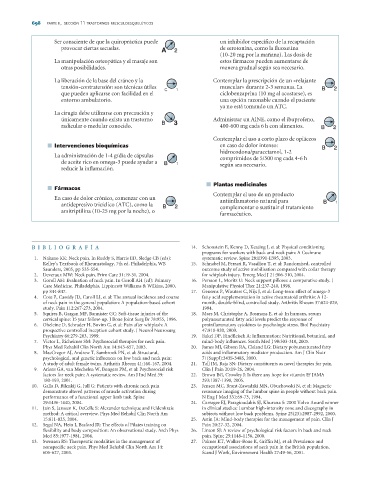Page 685 - medicina-integrativa_compress
P. 685
698 PARTE II, SECCIÓN 11 TRASTORNOS MUSCULOESQUELÉTICOS
Ser consciente de que la quiropráctica puede un inhibidor específico de la recaptación
provocar ciertas secuelas. A A 2 2 de serotonina, como la fluoxetina
(10-20 mg por la mañana). Las dosis de
La manipulación osteopática y el masaje son estos fármacos pueden aumentarse de
otras posibilidades. manera gradual según sea necesario.
La liberación de la base del cráneo y la Contemplar la prescripción de un «relajante
tensión-contratensión son técnicas útiles muscular» durante 2-3 semanas. La
C 1 B B 2 2
que pueden aplicarse con facilidad en el ciclobenzaprina (10 mg al acostarse), es
entorno ambulatorio. una opción razonable cuando el paciente
ya no está tomando un ATC.
La cirugía debe utilizarse con precaución y
únicamente cuando exista un trastorno Administrar un AINE, como el ibuprofeno,
radicular o medular conocido. B B 3 3 400-600 mg cada 6 h con alimentos. B B 2 2
Contemplar el uso a corto plazo de opiáceos
■ Intervenciones bioquímicas en caso de dolor intenso: B B 2 2
hidrocodona/paracetamol, 1-2
La administración de 1-4 g/día de cápsulas comprimidos de 5/500 mg cada 4-6 h
de aceite rico en omega-3 puede ayudar a B B 1 según sea necesario.
reducir la inflamación.
■ Plantas medicinales
■ Fármacos
Contemplar el uso de un producto
En caso de dolor crónico, comenzar con un antiinflamatorio natural para
antidepresivo tricíclico (ATC), como la B B 2 2 complementar o sustituir el tratamiento B B 1
amitriptilina (10-25 mg por la noche), o
farmacéutico.
BIBLIOGRAFÍA 14. Schonstein E, Kenny D, Keating J, et al: Physical conditioning
programs for workers with back and neck pain: A Cochrane
1. Nakano KK: Neck pain. In Ruddy S, Harris ED, Sledge CB (eds): systematic review. Spine 28:E391-E395, 2003.
Kelley’s Textbook of Rheumatology, 7th ed. Philadelphia, WB 15. Schnabel M, Ferrari R, Vassiliou T, et al: Randomised, controlled
Saunders, 2005, pp 535-554. outcome study of active mobilisation compared with collar therapy
2. Deveraux MW: Neck pain. Prim Care 31:19-31, 2004. for whiplash injury. Emerg Med J 21:306-310, 2004.
3. Goroll AH: Evaluation of neck pain. In Goroll AH (ed): Primary 16. Persson L, Moritz U: Neck support pillows: a comparative study. J
Care Medicine. Philadelphia, Lippincott Williams & Wilkins, 2000, Manipulative Physiol Ther 21:237-240, 1998.
pp 844-847. 17. Geusens P, Wouters C, Nijs J, et al: Long-term effect of omega-3
4. Cote P, Cassidy JD, Caroll LJ, et al: The annual incidence and course fatty acid supplementation in active rheumatoid arthritis: A 12-
of neck pain in the general population: A population-based cohort month, double-blind, controlled study. Arthritis Rheum 37:824-829,
study. Pain 112:267-273, 2004. 1994.
5. Squires B, Gargan MF, Bannister GC: Soft-tissue injuries of the 18. Maes M, Christophe A, Bosmans E, et al: In humans, serum
cervical spine: 15 year follow-up. J Bone Joint Surg Br 78:955, 1996. polyunsaturated fatty acid levels predict the response of
6. Obeleine D, Schrader H, Bovim G, et al: Pain after whiplash: A proinflammatory cytokines to psychologic stress. Biol Psychiatry
prospective controlled inception cohort study. J Neurol Neurosurg 47:910-920, 2000.
Psychiatry 66:279-283, 1999. 19. Rakel DP, Rindfleisch A: Inflammation: Nutritional, botanical, and
7. Victor L, Richeimer SM: Psychosocial therapies for neck pain. mind-body influences. South Med J 98:303-310, 2005.
Phys Med Rehabil Clin North Am 14:643-657, 2003. 20. James MJ, Gibson RA, Cleland LG: Dietary polyunsaturated fatty
8. MacGregor AJ, Andrew T, Sambrook PN, et al: Structural, acids and inflammatory mediator production. Am J Clin Nutr
psychological, and genetic influences on low back and neck pain: 71(Suppl):343S-348S, 2000.
A study of adult female twins. Arthritis Rheum 41:160-167, 2004. 21. Tall JM, Raja SN: Dietary constituents as novel therapies for pain.
9. Ariens GA, van Mechelen W, Bongers PM, et al: Psychosocial risk Clin J Pain 20:19-26, 2004.
factors for neck pain: A systematic review. Am J Ind Med 39: 22. Brown BG, Crowley J: Is there any hope for vitamin E? JAMA
180-193, 2001. 293:1387-1390, 2005.
10. Galla D, Bilenkij G, Jull G: Patients with chronic neck pain 23. Jensen MC, Brant-Zawadzki MN, Obuchowski N, et al: Magnetic
demonstrate altered patterns of muscle activation during resonance imaging of the lumbar spine in people without back pain.
performance of a functional upper limb task. Spine N Eng J Med 331:69-73, 1994.
29:1436-1440, 2004. 24. Carragee EJ, Paragioudakis SJ, Khurana S: 2000 Volvo Award winner
11. Jain S, Janssen K, DeCelle S: Alexander technique and Feldenkrais in clinical studies: Lumbar high-intensity zone and discography in
method: A critical overview. Phys Med Rehabil Clin North Am subjects without low back problems. Spine 25(23):2987-2992, 2000.
15:811-825, 2004. 25. Astin JA: Mind-body therapies for the management of pain. Clin J
12. Segal NA, Hein J, Basford JR: The effects of Pilates training on Pain 20:27-32, 2004.
flexibility and body composition: An observational study. Arch Phys 26. Linton SJ: A review of psychological risk factors in back and neck
Med 85:1977-1981, 2004. pain. Spine 25:1148-1156, 2000.
13. Swensen RS: Therapeutic modalities in the management of 27. Palmer KT, Walker-Bone K, Griffin MJ, et al: Prevalence and
nonspecific neck pain. Phys Med Rehabil Clin North Am 14: occupational associations of neck pain in the British population.
605-627, 2003. Scand J Work, Environment Health 27:49-56, 2001.

